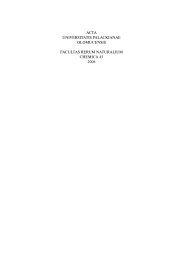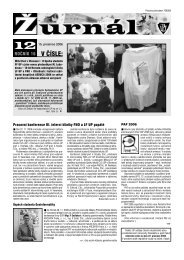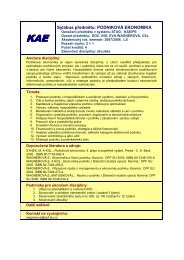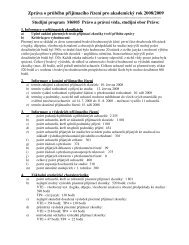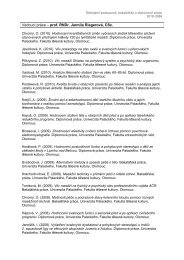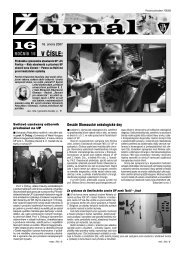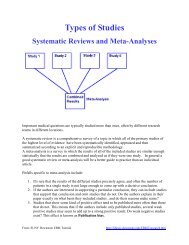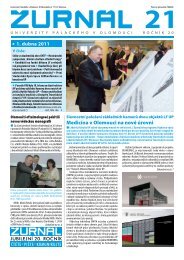ACTA UNIVERSITATIS PALACKIANAE OLOMUCENSIS GYMNICA ...
ACTA UNIVERSITATIS PALACKIANAE OLOMUCENSIS GYMNICA ...
ACTA UNIVERSITATIS PALACKIANAE OLOMUCENSIS GYMNICA ...
- No tags were found...
You also want an ePaper? Increase the reach of your titles
YUMPU automatically turns print PDFs into web optimized ePapers that Google loves.
Acta Univ. Palacki. Olomuc., Gymn. 2004, vol. 34, no. 2 27TABLE 5Lower limbs assessment in boys and girlsLower limbsNormal Varus Valgusn % n % n %Boys 590 95.00 25 4.00 6 1.00Girls 529 91.20 15 2.59 36 6.21Fig. 7Lower limbs assessment in boys and girls100% 9080706050403020100boysnormal varus valgusgirlsprobands (right shoulder higher in 38%, left shoulderhigher in 34.1% of girls).In probands with scoliotic posture, the uneven heightof the paravertebral muscle groups occurred regularly;the muscles were unevenly dislocated at the both sidesof the spine, when a boy or a girl gradually bent forwardand then unbent from a deep forward bend. The forwardbend or following unbending was frequently accompaniedwith turning the trunk to the side.Scoliotic posture was found in all probands witha flat back, where the physiological spine bend was notapparent. A fl at back was found in 44 boys, i.e. 7.1%and in 62 girls, i.e. 10.7% of the sample. A fl at backappeared especially in asthenic probands with generalmuscle slackness.The flat back, as stated by Srdečný et al. (1982), respectivelyflat spine, has lower resistance against higherloads. The flat spine efforts to balance the load exertedon it and this can result in lateral deflection. Srdečný etal. (1982) attracts attention to the dangerous combinationof a fl at back and scoliotic posture as the lowestdegree of scoliosis, i.e. a serious defect manifestingitself in changes of structure, rotation and the shape ofvertebrae and their deformities.The last area of posture assessment in accordancewith the Jaroš and Lomíček method (1957) is the evaluationof the lower limbs. Unlike the previous areas, thisevaluation brings much better results. Normal postureof lower limbs was found in 590 (95%) boys and 529(91.2%) girls. Valgus posture of limbs was found in 1%of boys and 6.21% of girls. Varus posture of limbs occurredin 4% of boys and 2.59% of girls (TABLE 5 andFig. 7).Together with the posture assessment, the foot archwas evaluated in accordance with the method stated byKlementa (1987). The results imply that in boys, a normalfoot arch occurs in the right foot in 84.4% and inthe left foot in 84.3% of probands, flat foot occurs in theright foot in 10.1% of cases and in the left foot in 7.5%of the cases and a high foot arch was found in the rightfoot in 5.5% and in the left foot in 8.2% of boys. In girls,a normal foot arch was found in the right foot in 85.5%and in the left foot in 84.4% of girls. In comparison withboys, girls had a lower number of flat feet, 2.8% in theright foot and 3.3% in the left foot, and a higher numberin the high foot arch, 11.7% in the right foot and 12.3%in the left foot.In the questionnaire asking about the health conditionof the spine, the question “Does your back hurtduring the day?” was answered “Yes” by 5.7% of theboys and by 9.5% of the girls. Occasional pain occursin 30.3% of the boys and in 42.8% of the girls. The secondquestion, “In which part of the spine does the painoccur most often?”, was answered “cervical spine” by10% of the boys and 18.9% of the girls, “thorax spine”by 11.5% of the boys and 13.3% of the girls and “lumbarspine” by 18.7% of the boys and 19.1% of the girls.Generally, the above results of the posture assessmentof Olomouc boys and girls confirm an unfavourabletrend. The assessment results imply that 57% ofboys and 37% of girls with defective posture should attendsome remedial training programs. However, sucha remedial training program is not offered at any of theseven schools where the survey was carried out, whichis a very surprising finding.CONCLUSIONThe above results and the presented data from literaturesuggest that the occurrence of defective posture isvery high in the present-day school age population. Theassessment results imply that:1. Defective posture appears in 57% of boys and 37% ofgirls in the age group 7–15 years.2. The main reason for the defective posture is musculardysbalance, the so-called upper cross syndromeand lower cross syndrome manifested in keeping thehead stuck forward, a round back, outstanding shoulderblades, high pelvis inclination accompanied with lumbarlordosis, and in many cases with loose abdominalmuscles.3. Scoliotic posture was found in 69% of boys and 62%of girls. A typical example of this functional disease isthe uneven height of the shoulders and shoulder blades,



